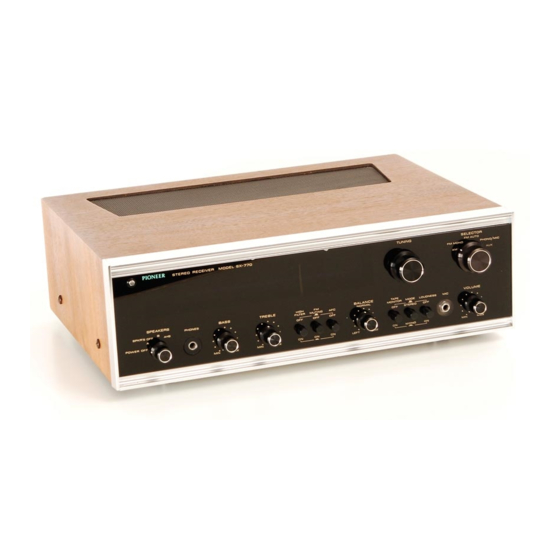Pioneer SX-770 설치, 운영 및 서비스 매뉴얼 - 페이지 15
{카테고리_이름} Pioneer SX-770에 대한 설치, 운영 및 서비스 매뉴얼을 온라인으로 검색하거나 PDF를 다운로드하세요. Pioneer SX-770 25 페이지. Solid state am-fm stereo receiver

EPIONEE.R
CONDITIONS FREQI,'ENTLY MISTAKEN FOR TROUBLES
Noise:
There are
a
variety
of
noises
relating
to
the operation of
a
hi-fi unit.
These are generally
divided
into two
types;
{1}
the
unit
is
faulty
(a
transistor
or
part
is deteriorated)
and
(2)
an
external source
of
noise gives noise
to
the unit.
When
a
hi-fi unit
produces an unpleasant noise,
it
is
often
ludged
that
the
unit
is
faulty, but
statistical records indicate
that
the
majority
of
noises
produced
in
hi'fi
acoustic
units
result from
external
sources
of
noise. Due
to
the
inherent
high
sensitivity
Further, watch the following
conditions:
These are also
apt
to
be
mistaken
for
troubles
of
the unit.
and
the
high
fidelity
in
reproduction,
the unit
amplifies
and
reproduces
extraneous
noises. however
small,
into definite
out-
put
noise.
lf
your
receiver produces
a
noise,
check
according
to
the following
table and trace
out
the
source
of
noise
for
an
appropriate
corrective action.
The table
includes
the
conditions
that
may be
mistaken
for
troubles
of
the unit.
Symptom
Suspected
Source
of
Noise
Diagnosis
and Remedy
a
o
o
co
o
o
.9
c
o
.9
J
C
o
c
3
Continuous or
intermittent
noise
like
jjijij
or
zzzzzz.
a
Statics
or
listening.
o
Fluorescent
lamp,
motor, or
thermo-
stat
may be
used
in
house
or
in the
vicinity of
the
house.
ln
many
cases,
it
is
very
difficult
to
remove the source
of
noise.
ln
order
to
increase
the radio
input
larger
than the
noise
level,
set
up a
good
outdoor
antenna
and make
a
complete grounding.
When
a
station
is
tuned
in,
hum
is
mixed
in
the
program.
o Poor
f
luorescent lamp, motor,
or
electric
heater may be
used
in
house
or
near the
house.
Reversing
the line plug may
occasionally alleviate
this
noise
problem. Usually
it
is
very
difficult
to eliminate
the
noise.
Hissing sound noise
in
AM
(medium wave) reception.
o
The
frequency
of
an
adlacent
station
is
interfering
with
that
of
the station
being
tuned in
(1OkHz beat interference).
a
TV
set is
on in
the
same
house
with
the
receiver.
lmpossible
to
remove such interference.
lf
the
cause
of
such noise
is
in
the TV
set,
increase
the
distance
between the
TV
set
and
receiver.
Static
noise
in
FM
recep-
tion
(in
particular,
when
automobiles
run
close to
the
housel.
a
White
noises generated
from
automobile
engines.
a
Radio frequency
sewing machine
or
weld-
ding machine being
used near
your
house,
ln
an
area
surrounded
by
hills
or
high buildings, the
FM input
signals
are very weak. Thus
the
noise
limiter
in
the
circuit
loses
its
function.
Set up
an
outdoor
FM
antenna having many
reflector
elements.
!
o
O
o
E
o
.g
G
o-
o
T
3
Beception
of FM
stereo
program
contains
more
noise
than FM mono
pro-
gram.
O
Note
that
the
service area covered
by
an
FM
stereo broadcast is
about 5fflo
of
that
of
a
regular
mono
broadcast.
lncreasing
FM input
signal may alleviate
this
problem.
Use
an exclusive
FM outdoor
antenna instead
of
the
indoor
T-antenna.
H
um
or
buzz,
When
switch-
ed
to
radio
reception,
the
noise
will
disappear.
O Poor
connection of
shielded
wire
(a)
o
Jack
connection
is
loose. (b).
O
Line cord or
fluorescent lamp
is near the
shielded
wire.
(cl
o
Poor
grounding.
(d)
O
HAM transmitting station
or
TV
transmit-
ting station
is near
your
house.
(e)
Correct
the
conditions stated
in
(a),
(b),
(c)
or
(d).
ln
case
of
(e),
report
it to
an
official
activity.
Output
tone
quality
ispoor
and mixed
with
noise.
Treble
is
not
clear.
o
Stylus
is
worn out.
(a)
o
Record
is
worn
out.
(bl
o
Dust
adheres
to stylus.
(c)
o
lmproper mounting of stylus.
(d)
o
Stylus
pressure is
not proper.
(e)
O The
TREBLE
sound level
is
too
high.
Check (a)
through
(e) and
correct
the
condition.
Lower
the
TREBLE
level.
Y*,
Symptom
Suspected
Source
of
Noise
Diagnosis and Remedy
Power
is
not
turned
on
al-
though the power switch
is
set
to
ON.
o
Fuse is
blown.
(a)
a
Line
plug
is
loose.
(b)
Check (a) and
(b)
and
correct
the
condition.
ln
playing
a
record,
increas-
ing
the
volume
will
cause
howling.
a
Distance
betvveen
the
record
player
and
the
speakers is
too
short.
o The
place
on which the
record player
or
speakers are set is
unstable.
Change
the
distance
or
rearrange
the
installation
po-
sitions
of
the
unit
and speakers.
(lnstalllng
the record
player
on a
f
irm,
solid stand may
alleviate
this
prob-
lem.) Do not
enhance
the
BASS
sound
level excessively.
l"*
